engine CITROEN C4 SPACETOURER 2022 Service Manual
[x] Cancel search | Manufacturer: CITROEN, Model Year: 2022, Model line: C4 SPACETOURER, Model: CITROEN C4 SPACETOURER 2022Pages: 316, PDF Size: 10.36 MB
Page 107 of 316
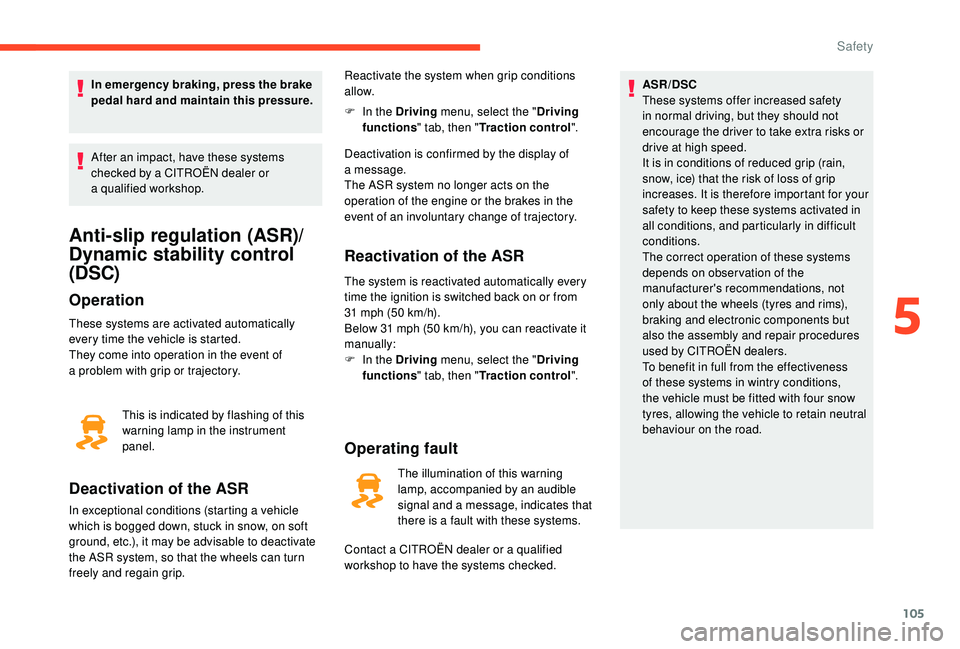
105
In emergency braking, press the brake
pedal hard and maintain this pressure.
After an impact, have these systems
checked by a CITROËN dealer or
a
qualified workshop.
Anti-slip regulation (ASR)/
Dynamic stability control
(DSC)
Operation
These systems are activated automatically
every time the vehicle is started.
They come into operation in the event of
a problem with grip or trajectory.
Deactivation of the ASR
In exceptional conditions (starting a vehicle
w hich is bogged down, stuck in snow, on soft
ground, etc.), it may be advisable to deactivate
the ASR system, so that the wheels can turn
freely and regain grip. F
I
n the Driving
menu, select the " Driving
functions " tab, then " Traction control".
Deactivation is confirmed by the display of
a
message.
The ASR system no longer acts on the
operation of the engine or the brakes in the
event of an involuntary change of trajectory.
Reactivation of the ASR
The system is reactivated automatically every
time the ignition is switched back on or from
31
mph (50 km/h).
Below 31
mph (50 km/h), you can reactivate it
manually:
F
I
n the Driving menu, select the " Driving
functions " tab, then " Traction control".
Operating fault
The illumination of this warning
lamp, accompanied by an audible
signal and a
message, indicates that
there is a
fault with these systems. ASR/DSC
These systems offer increased safety
in normal driving, but they should not
encourage the driver to take extra risks or
drive at high speed.
It is in conditions of reduced grip (rain,
snow, ice) that the risk of loss of grip
increases. It is therefore important for your
safety to keep these systems activated in
all conditions, and particularly in difficult
conditions.
The correct operation of these systems
depends on observation of the
manufacturer's recommendations, not
only about the wheels (tyres and rims),
braking and electronic components but
also the assembly and repair procedures
used by CITROËN dealers.
To benefit in full from the effectiveness
of these systems in wintry conditions,
the vehicle must be fitted with four snow
tyres, allowing the vehicle to retain neutral
behaviour on the road.
This is indicated by flashing of this
warning lamp in the instrument
panel. Reactivate the system when grip conditions
allow.
Contact a
CITROËN dealer or a qualified
workshop to have the systems checked.
5
Safety
Page 110 of 316
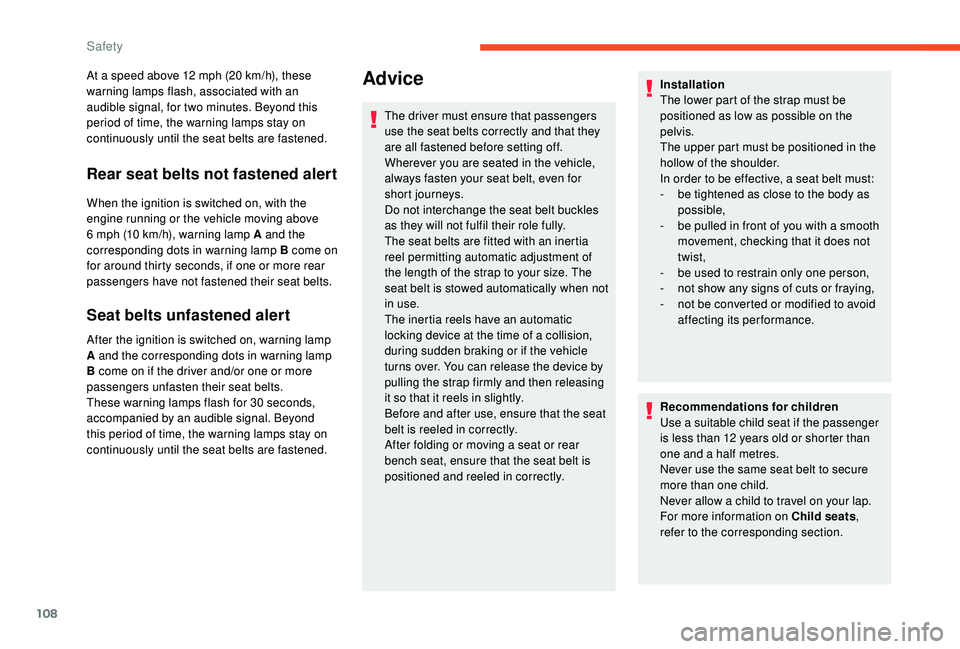
108
At a speed above 12 mph (20 km/h), these
w arning lamps flash, associated with an
audible signal, for two minutes. Beyond this
period of time, the warning lamps stay on
continuously until the seat belts are fastened.
Rear seat belts not fastened alert
When the ignition is switched on, with the
engine running or the vehicle moving above
6
mph (10 km/h), warning lamp A and the
corresponding dots in warning lamp B come on
for around thirty seconds, if one or more rear
passengers have not fastened their seat belts.
Seat belts unfastened alert
After the ignition is switched on, warning lamp
A and the corresponding dots in warning lamp
B come on if the driver and/or one or more
passengers unfasten their seat belts.
These warning lamps flash for 30
seconds,
accompanied by an audible signal. Beyond
this period of time, the warning lamps stay on
continuously until the seat belts are fastened.
Advice
The driver must ensure that passengers
use the seat belts correctly and that they
are all fastened before setting off.
Wherever you are seated in the vehicle,
always fasten your seat belt, even for
short journeys.
Do not interchange the seat belt buckles
as they will not fulfil their role fully.
The seat belts are fitted with an inertia
reel permitting automatic adjustment of
the length of the strap to your size. The
seat belt is stowed automatically when not
in use.
The inertia reels have an automatic
locking device at the time of a
collision,
during sudden braking or if the vehicle
turns over. You can release the device by
pulling the strap firmly and then releasing
it so that it reels in slightly.
Before and after use, ensure that the seat
belt is reeled in correctly.
After folding or moving a
seat or rear
bench seat, ensure that the seat belt is
positioned and reeled in correctly. Installation
The lower part of the strap must be
positioned as low as possible on the
pelvis.
The upper part must be positioned in the
hollow of the shoulder.
In order to be effective, a seat belt must:
-
b
e tightened as close to the body as
possible,
-
b
e pulled in front of you with a smooth
movement, checking that it does not
twist,
-
b
e used to restrain only one person,
-
n
ot show any signs of cuts or fraying,
-
n
ot be converted or modified to avoid
affecting its performance.
Recommendations for children
Use a
suitable child seat if the passenger
is less than 12
years old or shorter than
one and a
half metres.
Never use the same seat belt to secure
more than one child.
Never allow a
child to travel on your lap.
For more information on Child seats ,
refer to the corresponding section.
Safety
Page 128 of 316

126
Driving advice
Observe driving regulations and remain vigilant
whatever the traffic conditions.
Pay close attention to the traffic and keep your
hands on the wheel so that you are ready to
react at any time to any eventuality.
As a safety measure, the driver should only
carry out any operations that require close
attention when the vehicle is stationary.
On a
long journey, taking a break every two
hours is strongly recommended.
In difficult weather, drive smoothly, anticipate
the need to brake and increase the distance
from other vehicles.
Never leave the engine running in
an enclosed area without adequate
ventilation: internal combustion engines
emit toxic exhaust gases, such as carbon
monoxide. There is a
risk of poisoning and
death!
In very severe wintry conditions
(temperatures below -23°C), to guarantee
correct operation and the longevity of
the mechanical elements of your vehicle
(engine and gearbox), the engine must be
left running for 4
minutes before driving.
Important!
Never drive with the parking brake applied
– Risk of overheating and damage to the
braking system!
As the exhaust system of your vehicle
is very hot, even several minutes after
switching off the engine, never park or run
the engine on inflammable sur faces (dry
grass, fallen leaves, etc.) – Risk of fire!
Never leave a vehicle unsuper vised with
the engine running. If you have to leave
your vehicle with the engine running, apply
the parking brake and put the gearbox into
neutral or position N or P , depending on
the type of gearbox.
Driving on flooded roads
We strongly advise against driving on flooded
roads, as this could cause serious damage
to the engine or gearbox, as well as to the
electrical systems of your vehicle. If you are obliged to drive on a
flooded road:
-
c
heck that the depth of water does not
exceed 15 cm, taking account of waves that
might be generated by other users,
-
d
eactivate the Stop & Start function,
-
d
rive as slowly as possible without stalling.
In all cases, do not exceed 6 mph (10 km/h),
-
d
o not stop and do not switch off the engine.
On leaving the flooded road, as soon as safety
conditions allow, make several light brake
applications to dry the brake discs and pads.
If in doubt on the state of your vehicle, contact
a CITROËN dealer or a qualified workshop.
Driving
Page 129 of 316
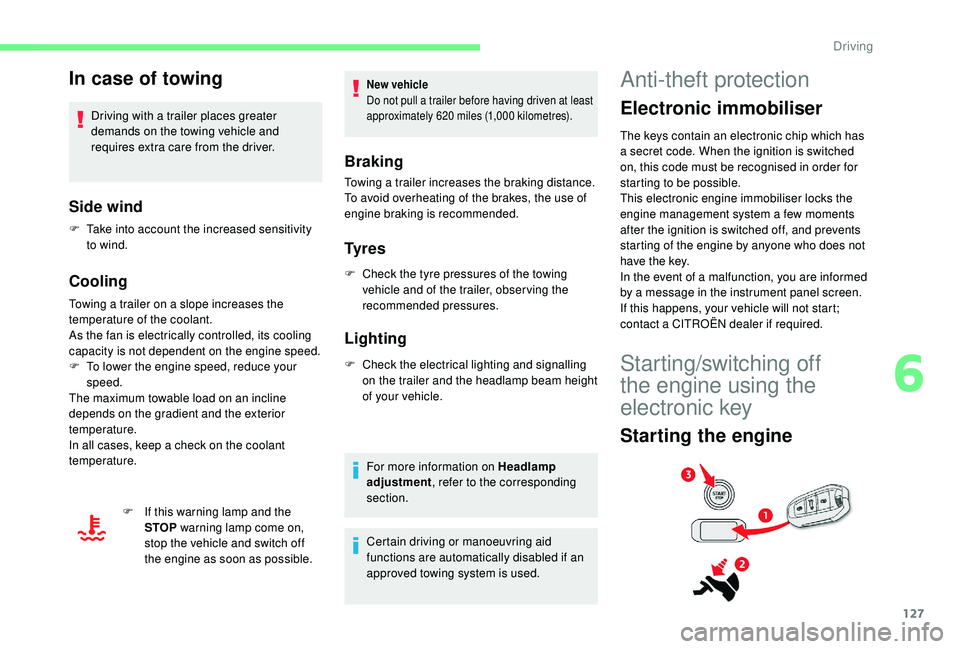
127
In case of towing
Driving with a trailer places greater
d emands on the towing vehicle and
requires extra care from the driver.
Side wind
F Take into account the increased sensitivity to wind.
Cooling
Towing a trailer on a slope increases the
t emperature of the coolant.
As the fan is electrically controlled, its cooling
capacity is not dependent on the engine speed.
F
T
o lower the engine speed, reduce your
speed.
The maximum towable load on an incline
depends on the gradient and the exterior
temperature.
In all cases, keep a
check on the coolant
temperature.
F
I
f this warning lamp and the
STOP warning lamp come on,
stop the vehicle and switch off
the engine as soon as possible.
New vehicle
Do not pull a trailer before having driven at least
approximately 620
miles (1,000
kilometres).
Braking
Towing a trailer increases the braking distance.
T o avoid overheating of the brakes, the use of
engine braking is recommended.
Ty r e s
F Check the tyre pressures of the towing vehicle and of the trailer, observing the
recommended pressures.
Lighting
F Check the electrical lighting and signalling on the trailer and the headlamp beam height
of your vehicle.
For more information on Headlamp
adjustment , refer to the corresponding
section.
Certain driving or manoeuvring aid
functions are automatically disabled if an
approved towing system is used.
Anti-theft protection
Electronic immobiliser
The keys contain an electronic chip which has
a secret code. When the ignition is switched
on, this code must be recognised in order for
starting to be possible.
This electronic engine immobiliser locks the
engine management system a
few moments
after the ignition is switched off, and prevents
starting of the engine by anyone who does not
have the key.
In the event of a
malfunction, you are informed
by a
message in the instrument panel screen.
If this happens, your vehicle will not start;
contact a
CITROËN dealer if required.
Starting/switching off
the engine using the
electronic key
Starting the engine
6
Driving
Page 130 of 316
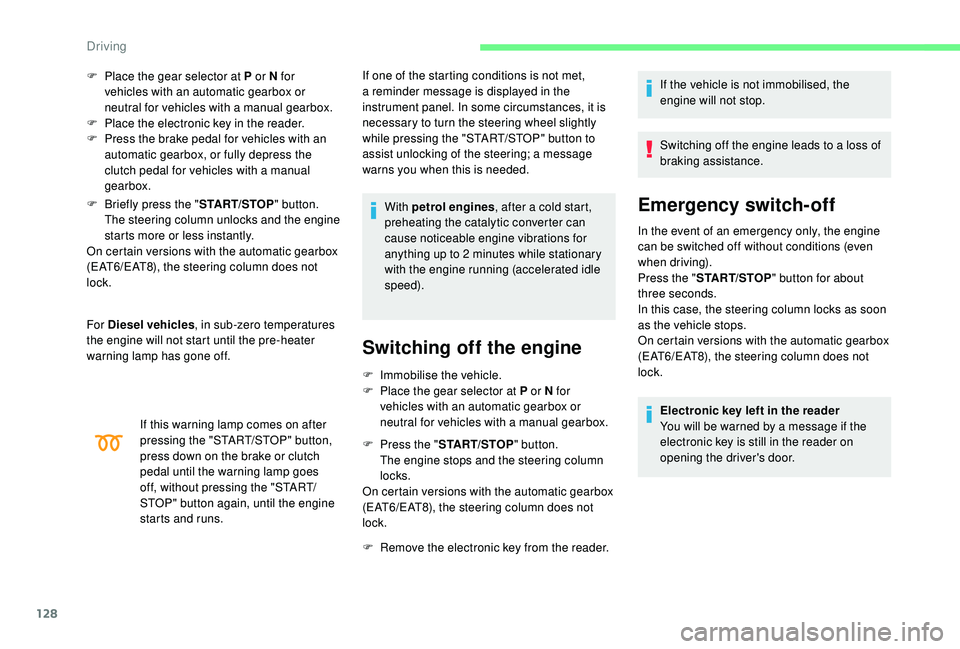
128
F Place the gear selector at P or N for vehicles with an automatic gearbox or
neutral for vehicles with a
manual gearbox.
F
P
lace the electronic key in the reader.
F
P
ress the brake pedal for vehicles with an
automatic gearbox, or fully depress the
clutch pedal for vehicles with a
manual
gearbox.
F
B
riefly press the " START/STOP" button.
The steering column unlocks and the engine
starts more or less instantly.
On certain versions with the automatic gearbox
(EAT6/EAT8), the steering column does not
lock.
For Diesel vehicles , in sub-zero temperatures
the engine will not start until the pre-heater
warning lamp has gone off. If one of the starting conditions is not met,
a reminder message is displayed in the
instrument panel. In some circumstances, it is
necessary to turn the steering wheel slightly
while pressing the "START/STOP" button to
assist unlocking of the steering; a message
warns you when this is needed.
With petrol engines , after a
cold start,
preheating the catalytic converter can
cause noticeable engine vibrations for
anything up to 2
minutes while stationary
with the engine running (accelerated idle
speed).
If this warning lamp comes on after
pressing the "START/STOP" button,
press down on the brake or clutch
pedal until the warning lamp goes
off, without pressing the "START/
STOP" button again, until the engine
starts and runs.
Switching off the engine
F Immobilise the vehicle.
F P lace the gear selector at P or N for
vehicles with an automatic gearbox or
neutral for vehicles with a
manual gearbox.
F
P
ress the " START/STOP " button.
The engine stops and the steering column
locks.
On certain versions with the automatic gearbox
(EAT6/EAT8), the steering column does not
lock.
F
R
emove the electronic key from the reader. If the vehicle is not immobilised, the
engine will not stop.
Switching off the engine leads to a
loss of
braking assistance.
Emergency switch-off
In the event of an emergency only, the engine
can be switched off without conditions (even
when driving).
Press the " START/STOP " button for about
three seconds.
In this case, the steering column locks as soon
as the vehicle stops.
On certain versions with the automatic gearbox
(EAT6/EAT8), the steering column does not
lock.
Electronic key left in the reader
You will be warned by a
message if the
electronic key is still in the reader on
opening the driver's door.
Driving
Page 131 of 316

129
Starting/switching off the
engine with Keyless Entry
and Starting
Starting the engine
The Keyless Entry and Starting electronic
key must be inside the vehicle.
If the electronic key is not detected in this
zone, a message is displayed.
Move the electronic key into this zone so
that the engine can be started.
If there is still a problem, refer to the "Key
not detected – Back-up starting" section.
F
P
ress the " START/STOP " button while
maintaining pressure on the pedal until the
engine starts.
The steering column unlocks and the engine
starts.
On certain versions with the automatic gearbox
(EAT6/EAT8), the steering column does not
lock.
For Diesel engines , when the temperature is
negative and/or the engine is cold, the start
will only take place once the preheater warning
lamp is off. F
W ith an automatic gearbox
, you should
keep the brake pedal fully depressed and
not press the " START/STOP" button again
until the engine is running.
If one of the starting conditions is not met,
a reminder message is displayed in the
instrument panel.
In some circumstances, it is necessary to turn
the steering wheel slightly while pressing the
" START/STOP " button to assist unlocking of
the steering column.
With petrol engines , after a
cold start,
preheating the catalytic converter can
cause noticeable engine vibrations for
up to 2
minutes while stationary with the
engine running (accelerated idle speed).
As a
safety measure, never leave the
vehicle while the engine is running.
Switching off the engine
F Immobilise the vehicle, engine at idle.
F W ith a manual gearbox , preferably put the
gear lever into neutral.
F
W
ith a
manual gearbox
, put the gear lever
into neutral.
F
W
ith the electronic key inside the vehicle,
fully depress the clutch pedal.
or
F
W
ith an automatic gearbox
, place the gear
selector in mode P or N .
F
W
ith the electronic key inside the vehicle,
press the brake pedal.
If this warning lamp comes on after
pressing the "START/STOP " button:
F
W
ith a
manual gearbox , you should keep
the clutch pedal fully depressed and not
press the " START/STOP " button again until
the engine is running.
6
Driving
Page 132 of 316

130
F With the electronic key inside the vehicle, press the " START/STOP " button.
The engine stops and the steering column
locks.
In some circumstances, it is necessary to turn
the steering wheel to lock the steering column.
On certain versions with the automatic gearbox
(EAT6/EAT8), the steering column does not
lock, but the gearbox locks in mode P .
If the vehicle is not immobilised, the
engine will not stop.
Never leave your vehicle with the
electronic key still inside.
Switching off the engine leads to a
loss of
braking assistance.
Key not detected
Back-up starting
When the electronic key is in the recognition
zone and after pressing the "START/STOP"
button, the engine does not start:
F
P
lace the gear selector at P or N for
vehicles with an automatic gearbox or
neutral for vehicles with a
manual gearbox.
F
P
lace the electronic key in the back-up
reader.
F
P
ress the brake pedal on vehicles with an
automatic gearbox, or fully depress the
clutch pedal with a
manual gearbox.
F
P
ress the "START/STOP" button.
The engine starts.
F
W
ith an automatic gearbox
, preferably
select mode P or N .
Back-up switch-off
F To confirm the instruction to switch off the
engine, press the " START/STOP" button for
about three seconds.
In the event of a
fault with the electronic key,
contact a
CITROËN dealer or a qualified
workshop.
Emergency switch-off
In the event of an emergency only, the engine
can be switched off without conditions (even
when driving).
Press the " START/STOP " button for about
three seconds.
In this case, the steering column locks as soon
as the vehicle stops. When the electronic key is not detected or is
no longer in the recognition zone, a message
appears in the instrument panel when closing
a door or trying to switch off the engine.
Driving
Page 133 of 316
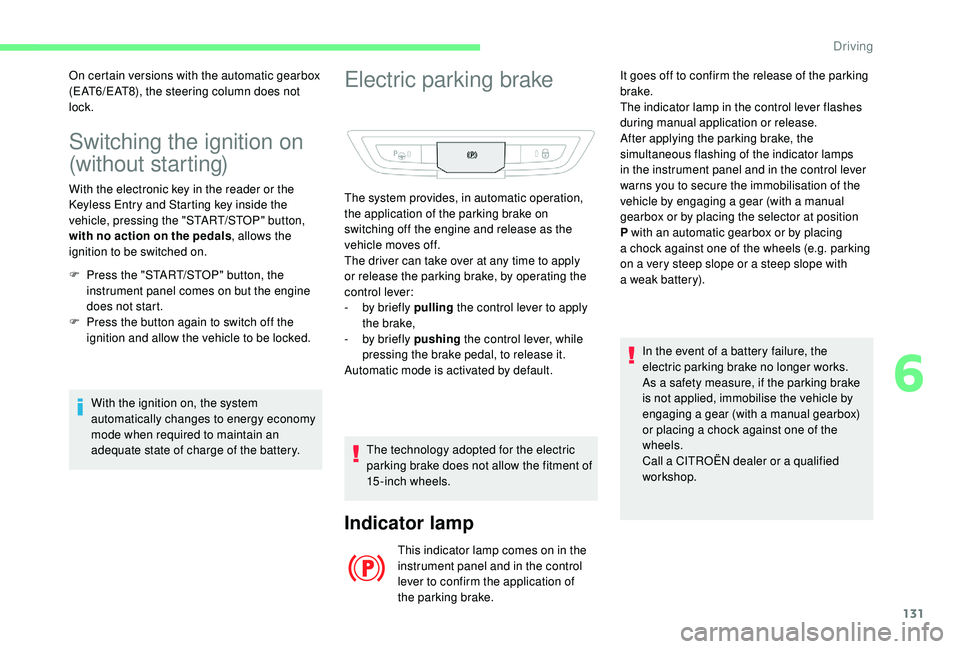
131
Switching the ignition on
(without starting)
With the electronic key in the reader or the
Keyless Entry and Starting key inside the
vehicle, pressing the "START/STOP" button,
with no action on the pedals, allows the
ignition to be switched on.
F
P
ress the "START/STOP" button, the
instrument panel comes on but the engine
does not start.
F
P
ress the button again to switch off the
ignition and allow the vehicle to be locked.
With the ignition on, the system
automatically changes to energy economy
mode when required to maintain an
adequate state of charge of the battery.
On certain versions with the automatic gearbox
(EAT6/EAT8), the steering column does not
lock.
Electric parking brake
The technology adopted for the electric
parking brake does not allow the fitment of
15-inch wheels.
Indicator lamp
This indicator lamp comes on in the
instrument panel and in the control
lever to confirm the application of
the parking brake. It goes off to confirm the release of the parking
brake.
The indicator lamp in the control lever flashes
during manual application or release.
After applying the parking brake, the
simultaneous flashing of the indicator lamps
in the instrument panel and in the control lever
warns you to secure the immobilisation of the
vehicle by engaging a
gear (with a manual
gearbox or by placing the selector at position
P with an automatic gearbox or by placing
a chock against one of the wheels (e.g. parking
on a very steep slope or a steep slope with
a weak battery).
In the event of a battery failure, the
electric parking brake no longer works.
As a safety measure, if the parking brake
is not applied, immobilise the vehicle by
engaging a
gear (with a
manual gearbox)
or placing a chock against one of the
wheels.
Call a CITROËN dealer or a qualified
workshop.
The system provides, in automatic operation,
the application of the parking brake on
switching off the engine and release as the
vehicle moves off.
The driver can take over at any time to apply
or release the parking brake, by operating the
control lever:
-
b
y briefly pulling
the control lever to apply
the brake,
-
b
y briefly pushing
the control lever, while
pressing the brake pedal, to release it.
Automatic mode is activated by default.
6
Driving
Page 134 of 316

132
Label on door panel
Before leaving the vehicle, check that the
parking brake is applied: the indicator
lamps in the instrument panel and the
control lever must be on fixed.
If the parking brake is not applied, there
is an audible signal and a message is
displayed on opening the driver's door.
Never leave a
child alone inside the
vehicle with the ignition on, as they could
release the parking brake. When towing, parking on a
steep slope,
or if your vehicle is heavily laden, turn
the wheels towards the kerb and engage
a gear (with a manual gearbox) or place
the gear selector at position P with an
automatic gearbox.
For towing, you vehicle is approved for
parking on slopes of up to 12%.
Manual operation
Manual release
With the ignition on or the engine running, to
release the parking brake:
F
p
ress the brake pedal,
F
w
hile maintaining pressure on the brake
pedal, briefly push the control lever.
The complete release of the parking brake is
confirmed by the brake indicator lamp and the
P indicator lamp in the control lever going off,
accompanied by the display of the message
"Parking brake released".
If you push the control lever without
pressing the brake pedal, the parking
brake will not be released and a
message
is displayed.
Manual application
With the vehicle stationary:
F p ull briefly on the control lever.
Confirmation of the instruction is signalled by
flashing of the indicator lamp in the control
l eve r.
Application of the parking brake is confirmed
by illumination of the brake indicator lamp
and the P indicator lamp in the control lever,
accompanied by the display of the message
"Parking brake applied".
Automatic operation
Automatic release
Ensure first that the engine is running and the
driver's door is properly closed.
The electric parking brake releases
automatically and progressively when the
vehicle moves off .
With a
manual gearbox
F
F
ully depress the clutch pedal, engage 1
st
gear or reverse.
F
P
ress the accelerator pedal and release the
clutch pedal.
With an automatic gearbox
F
P
ress the brake pedal.
F
R
elease the brake pedal and press the
accelerator pedal.
Driving
Page 135 of 316
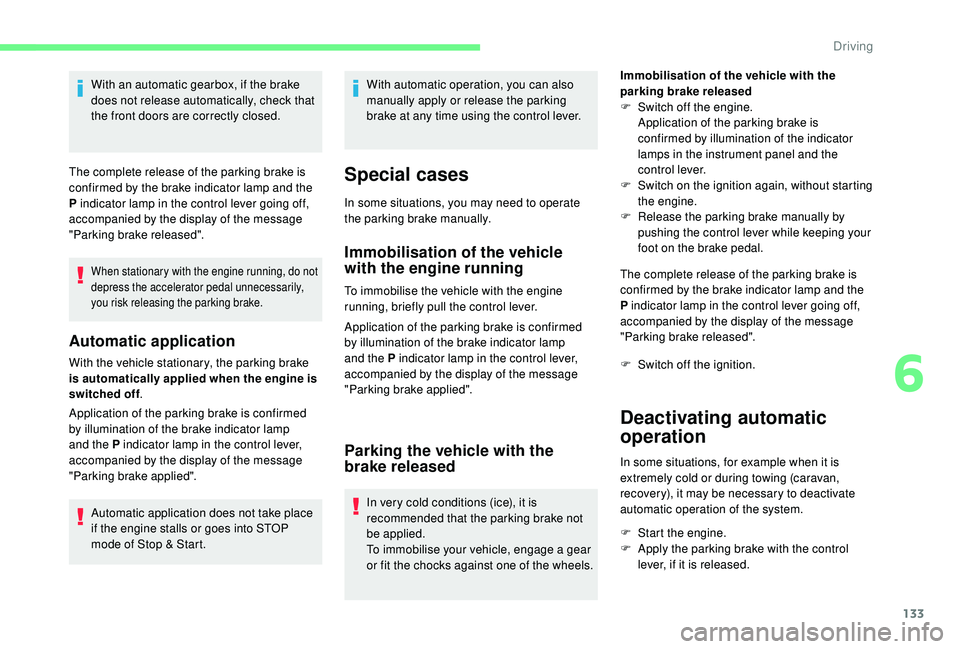
133
With an automatic gearbox, if the brake
does not release automatically, check that
the front doors are correctly closed.
The complete release of the parking brake is
confirmed by the brake indicator lamp and the
P indicator lamp in the control lever going off,
accompanied by the display of the message
"Parking brake released".
When stationary with the engine running, do not
depress the accelerator pedal unnecessarily,
you risk releasing the parking brake.
Automatic application
With the vehicle stationary, the parking brake
is automatically applied when the engine is
switched off .
Application of the parking brake is confirmed
by illumination of the brake indicator lamp
and the P indicator lamp in the control lever,
accompanied by the display of the message
"Parking brake applied".
Automatic application does not take place
if the engine stalls or goes into STOP
mode of Stop & Start. With automatic operation, you can also
manually apply or release the parking
brake at any time using the control lever.
Special cases
In some situations, you may need to operate
the parking brake manually.
Immobilisation of the vehicle
with the engine running
To immobilise the vehicle with the engine
running, briefly pull the control lever.
Application of the parking brake is confirmed
by illumination of the brake indicator lamp
and the P indicator lamp in the control lever,
accompanied by the display of the message
"Parking brake applied".
Parking the vehicle with the
brake released
In very cold conditions (ice), it is
recommended that the parking brake not
be applied.
To immobilise your vehicle, engage a
gear
or fit the chocks against one of the wheels. Immobilisation of the vehicle with the
parking brake released
F
S
witch off the engine.
Application of the parking brake is
confirmed by illumination of the indicator
lamps in the instrument panel and the
control lever.
F
S
witch on the ignition again, without starting
the engine.
F
R
elease the parking brake manually by
pushing the control lever while keeping your
foot on the brake pedal.
The complete release of the parking brake is
confirmed by the brake indicator lamp and the
P indicator lamp in the control lever going off,
accompanied by the display of the message
"Parking brake released".
F
S
witch off the ignition.
Deactivating automatic
operation
In some situations, for example when it is
extremely cold or during towing (caravan,
recovery), it may be necessary to deactivate
automatic operation of the system.
F
S
tart the engine.
F
A
pply the parking brake with the control
lever, if it is released.
6
Driving